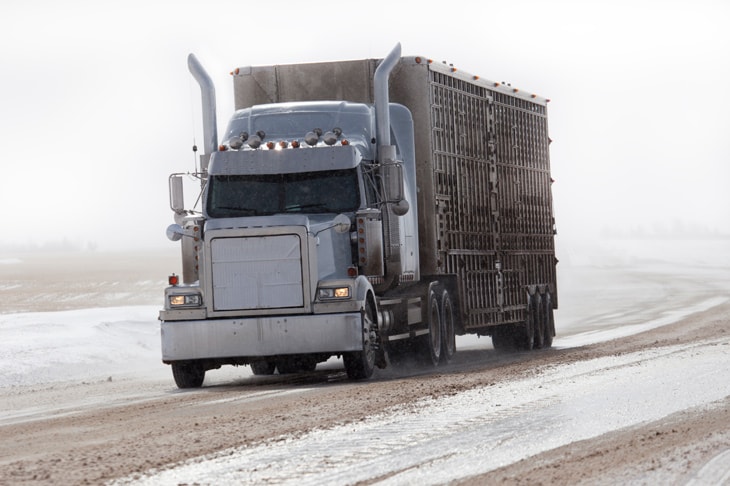#1 Like a good Boy Scout… Be Prepared!
When traveling in colder climates one must always be ready for whatever you may encounter. Yes, this is common sense… But how many of us jump in our vehicle when the weather looks nice and end up in a storm?
- Proper clothing (loose layers of clothing, extra gloves, rain gear)
- A coat to support the temperature for either day or night
- A flashlight in the glove box
- A blanket, food and water
- A bag of sand or salt and extra windshield washer fluid
- A windshield scraper
- Jumper cables
- Tire chains or traction mats
- Have at least a half tank of gas at all times during the winter
- Plan long trips carefully—what weather conditions may you encounter?
#2 Complete a Pre-Trip Inspection
Professional drivers are required to inspect their vehicles before every trip. We do a visual, hands-on inspection and check all important items, including tires, wiper blades, fluids, and lights. Check your vehicle more often due to temperatures.
#3 Slow down
Most winter accidents occur because drivers are going too fast for road conditions. A slower speed gives you more time to react if something occurs. Hydroplaning happens more frequently at higher speeds, including loss of control due to slush. Extra patience and care for other drivers can help a lot.
#4 Give yourself plenty of safe space
Following distance… Allow for more room between yourself and other vehicles. You should always have enough space and time to move out of harm’s way.
#5 Hold your steering wheel firmly
Sudden, sharp moves can quickly cause you to lose control of your vehicle. Keep your vehicle steady through ruts in the road, heavy wind and on ice. Keep both hands on wheel.
#6 Brake and accelerate lightly
Try not to do anything forcefully in bad weather. Anti-locking Braking Systems (ABS) can be your friend when used properly. If your vehicle has an anti-locking braking system (ABS), you should press and hold the brake down as far as possible in an emergency. The ABS prevents the wheels from locking, enabling you to steer around obstacles. If not equipped, when you need to slow down quickly in slippery conditions, try lightly pumping your brakes. This reduces your chance of locking your tires and spinning out of control.
#7 Watch for black ice!
Black ice is a dangerous road condition. It is a thin layer of transparent ice that forms when the temperature is close to freezing and sometimes makes the road look slightly wet. Never assume just because the sun is out that the road is just wet. Black Ice is difficult to spot, so when the temperature gets close to freezing, look for small clues:
- Ice build-up on a trucks mirror arms, antennas, or the top corners of the windshield
- The spray from tires on vehicles in front of you will stop
#8 Use extra caution when approaching bridges
Elevated structures, such as bridges and highway overpasses, usually freeze first, and many are not treated with ice-/snow-melt materials (salt, sand) like the rest of the road. Often vehicles are traveling fine on the highway, but as soon as they get on a bridge, they spin out of control. Black ice is often found on bridges.
#9 Mountain driving is often hazardous
Mountain weather can be severe and unpredictable in winter, often changing rapidly. Be ready for wind gusts and watch and/or listen for emergency vehicles and snowplows. If at all possible, do not stop in avalanche zones. Obey posted rules, each state varies. Tire chains may be required for certain routes.
#10 Obey all road signs
Safety authorities post warning information for a reason. I curve posted at 35 mph is posted as such because testing has determined that that is the maximum safe speed for ANY vehicle.
#11 If stranded or stuck, stay in your vehicle
If you get stuck in a bad storm, blizzard, slide off the road, and you can’t see a close place to seek assistance, stay put! It’s easy to get confused in a bad storm, and you may get lost. Bundle up. You should also keep moving to stay warm. Avoid carbon monoxide poisoning, keep the exhaust pipe clear of snow, and open a downwind window slightly for ventilation. Run your engine for only 10-15 minutes each hour.
#12 If conditions look bad, get off the road
Don’t push your luck and assume that plows have treated the roadways. Use your best judgment. Listen to weather reports and warnings and react appropriately.
The five keys are:
- Aim High in Steering: Make sure you’re looking far enough ahead of your vehicle, so you have time to react to any hazardous situation.
- Get the Big Picture: Look all around your vehicle.
- Keep Your Eyes Moving: Continuously scan the entire area.
- Leave Yourself an Out: Always have an escape plan for you and your vehicle.
- Make Sure They See You: Make other drivers aware of your presence.
“Slow down; you will spend more time correcting a mistake.”

